Ironsworn by Evil Mastermind
A lone warrior in a hostile land
Original SA post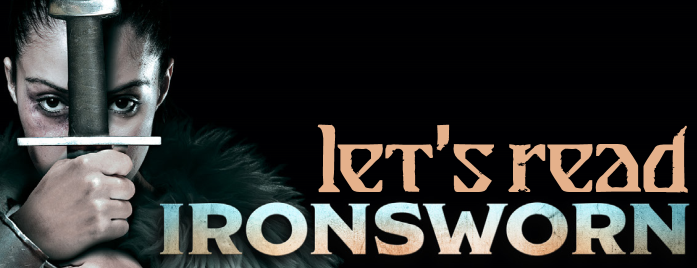
Part 1: A lone warrior in a hostile land
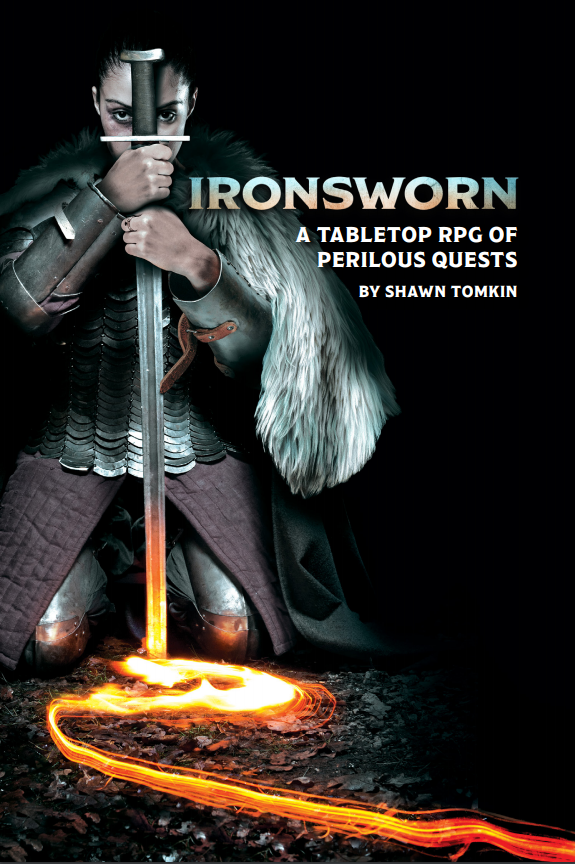
The idea of "solo roleplaying" seems like a self-contradictory one, doesn't it?
After all, one of the major selling points of a role-playing game is that it's a group activity. A lot of words have been written about things like the social contract, getting everyone on the same page, working as a group, and so on.
And yes, there are GMless games like Fiasco. But those operate in what's best described as a round-robin style; instead of one person pushing the narrative, everyone takes turns in some fashion. There's still a level of decision-making made by someone for someone else's character.
Truly "solo" gaming, involving a single person by themselves, doesn't come up too much. To a certain degree, it seems more like a writing exercise than a game. A few attempts at solo RPGs have been made, of course. Probably the most well-known is the Mythic Gamemaster Emulator, which tries to be a generic tool that can be applied to any existing RPG, but...well...
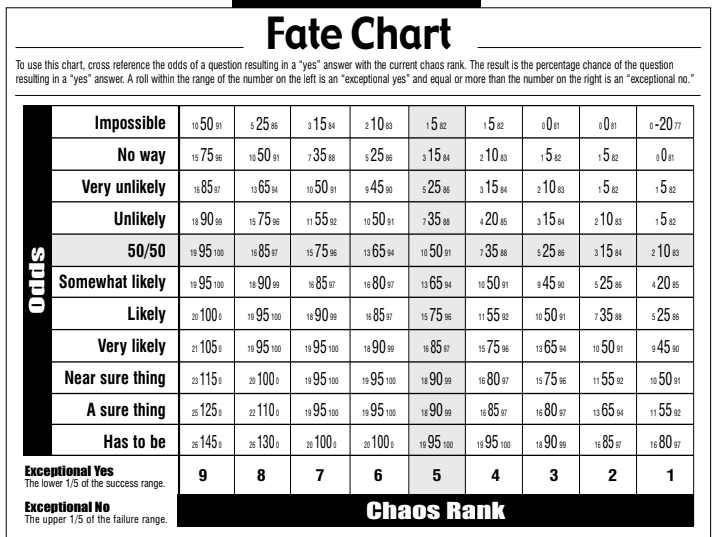
I mean, it works, but it's trying to be a universal tool for any RPG, and as such is way too general. I'm told there's an updated version but I haven't read it and anyway I don't want to get caught up in a sub-review here.
Scarlet Heroes by Kevin Crawford is an OSR style fantasy game designed for one-GM-and-one-player, but it also had a section about solo play. It was clearly based on Mythic, except that it used a much smaller table: "yes;yes, and;no, but;no" instead of a flat yes-no. It also included "oracles"; short random-roll tables that could be used to set a scene, get an interesting detail, and create twists on the fly. It sort of splits the responsibilities of the GM between the player and random chance, but it keeps the randomness focused on its genre so it's actually useful. However, it still has the feel of trying to rely too much on "roll to see where you are" and not as much as using the mechanics to help guide the player. It's still something that was attached to a system rather than being part the system itself.
And then there's Ironsworn.
Ironsworn, by Shawn Tomkin, is actually designed from the ground up to be a solo-play RPG (although it can be played by multiple players without a GM, or run traditionally by a GM), using PbtA and Blades inspired elements to provide focus and push the narrative forward. It does this by using a very interesting take on clocks, melding them with a push-your-luck mechanic that actually drives the player to take risks and do things that will generate an interesting story.
But enough of my rambling preamble. Let's look at the basics of Ironsworn. Which, coincidentally, is what the first chapter is all about.
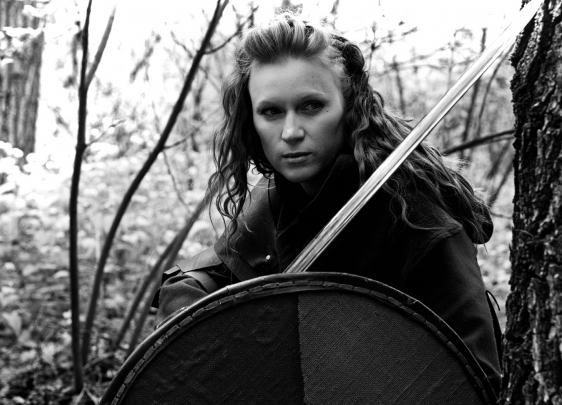
All the art in the book is incredibly well-done greyscale photography.
Before we get going into the first chapter (The Basics), I'd like to point out that Ironsworn is available for free via the official website, DriveThruRPG, and itch.io. The physical book is available as PoD on DriveThru, as are assorted play aids.
Ironsworn takes place in the Ironlands, a low-fantasy setting with a very Viking feel to it. There's stuff about making the setting your own that we'll get to later, but there are a few default assumptions:
- Your people were driven from their homelands to the Ironlands two generations ago.
- The land is harsh and the weather is brutal.
- Most of the land is unexplored. There are no kingdoms or large cities, just villages and steadings. Sometimes settlements will band together under a single leader when needed.
- There are beasts called the "Firstborn" in the unexplored lands. Elves, were-animals, and stranger things. Anything supernatural is feared.
- There's no real universal coinage; economies run mostly on barter.
- The main weapons that see use are spears, axes, and bows. Swords are rare, and prized by those who use them.
- Vows are sacred.
quote:
In the Ironlands, a vow is sacred. When you declare your solemn promise to serve or aid someone, or to complete a personal quest, your honor is bound to that vow. Abandoning or recanting an oath is the worst sort of failure. When you swear a vow, you touch a piece of iron. It can be an iron coin, a weapon, or your armor. It’s an old tradition. Some say the iron, a piece of the primal world, serves as a conduit to the old gods—so they may better hear your promise.
Vows are the core of playing Ironsworn. It is your vows that drive you. These goals create the context for your adventures and challenges. As you complete vows, you gain experience and new abilities.
But before we get too far into characters, let's talk about the base mechanics and related ideas.
Like a Powered by the Apocalypse game, Ironsworn uses specific moves that do things on a strong hit, a hit, or a miss.
Unlike PbtA games, however, you don't roll 2d6 and check the 10+/9-7/6-. Instead, you roll 2d10 and 1d6. The d6 is the action die and is what you add your stat and any modifiers to. You then compare this value to the two d10s, which are the challenge dice; if your action die+stat is higher than both of the d10s, then that's a strong hit. If it's only larger than one die, that's a normal hit, and if it's lower than both dice that's a miss. In addition, rolling doubles on the d10s results in a critical success or failure, depending on the overall outcome of the roll.

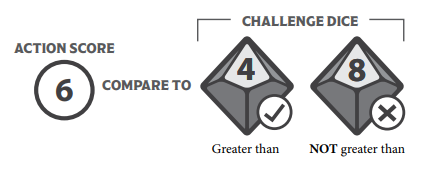
"But EM," I hear you say, "that sounds like it's easy to roll misses if you're just rolling dice to beat other dice." To help with this, characters have momentum. Momentum represents how in control of your general situation you are, and ranges from +10 to -6, defaulting to +2. Whenever you roll, if you have positive momentum, you can "burn" it to cancel any of the d10s that rolled under your current momentum. Cancelling one die results in a normal hit, if you cancel both it's a strong hit. Once you burn momentum, it goes back to its default value.
If your momentum is negative, however, your action die is cancelled if you rolled a matching value, leaving you with just your stat to compare to the d10s.
Momentum is mostly gained or lost from moves (and there's one move specifically to regain momentum), and as such managing it is an important part of the gameplay loop.
The other important part of the gameplay loop are Progress Trackers. These are similar to clocks in Blades, and always have 10 boxes.
There are four general types of progress trackers: vows (how far along you are in completing your mission), journey (getting from point A to point B), combat (defeating foes), and bond (making an ally). Each bond type (with the exception of Bonds) also has a rating of overall difficulty: troublesome, dangerous, formidable, extreme, and epic. Most tasks being dangerous or formidable, but the book provides guidelines on picking the right difficulty.
Each tracker type has a specific move that advances it, and those moves will tell you to "mark progress". A box is considered "filled" when it has four lines (called ticks) in a star pattern. The amount of ticks depends on the difficulty of the task: troublesome, dangerous, and formidable tasks will fill whole boxes, but extreme or epic tasks will only fill in a few ticks. Again, Bonds are an exception; these always mark one tick.
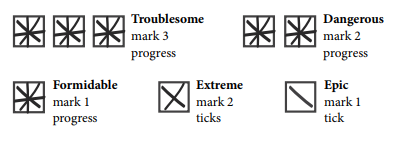
This is one of those things that makes more sense when you see it.
Let's say I want to go to Holmstead, which is a place I just made up. I give this journey a progress tracker and assign it a difficulty of "dangerous". This means that every time I mark progress according to the "Undertake a Journey" move, I'd fully fill in two boxes. Therefore, if I succeed at this move three times, I'd have six boxes filled. If this was an extreme journey, however, three successes would only complete one box and leave the second one half-complete.
Now, the important thing to note is this: the overall goal is not to fully fill the progress clock. Instead, there are "Progress Moves" that are rolled to see what the situation is when you try to bring whatever you're doing to completion. The thing about progress moves is that they are not rolled against your stats, they're rolled against the number of filled boxes on the track, without the benefit of stats or momentum.
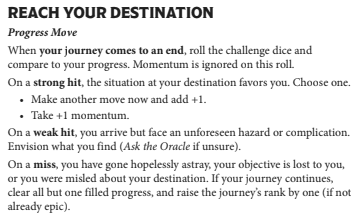
This creates a very interesting push-your-luck situation; you want to try to fill the progress tracker up as much as you can before finishing the quest/combat/whatever, but the more you make the progression moves, the more events will pop up and the greater the drain on your resources. So you have to balance pushing forward with the risks that come with failing rolls. And the more challenging the task, the more you have to make the progress roll (and deal with the consequences) to get to a point where you have a decent chance of succeeding at the overall task.
One last thing on moves before we talk about characters; there are two universal moves that are referenced by other moves. Pay the price is always triggered on a failure, and determines the consequences of your failure. Ask the Oracle is used whenever you need to figure out a detail or want to declaim decision-making to see what happens next. These don't roll like normal moves; each of these is "choose one of these options, or roll on this percentile chart."
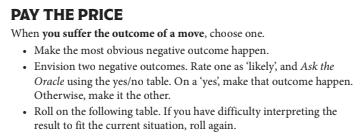
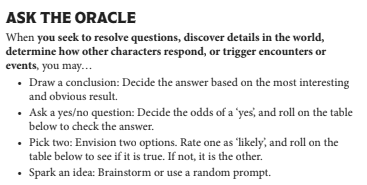
Despite being PbtA/Blades derived, Ironsword does not use classes or playbooks. Instead, characters have Assets, which can be companions, combat styles, special knowledge, or magic rituals. As characters complete their vows (which is to say, finish adventures), they'll gain access to more Assets. It's important to note that normal weapons or items aren't considered Assets; your mundane gear is covered by a Supply tracker. That said, there are Assets that make you better with certain items. For instance, you can just say you have a shield, but if you have the Shield-Bearer Asset, then you're more skilled with it and have more options.
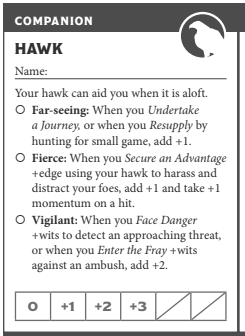
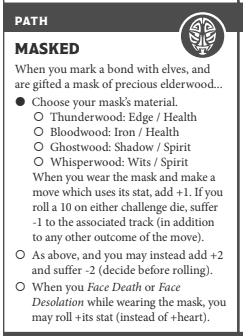
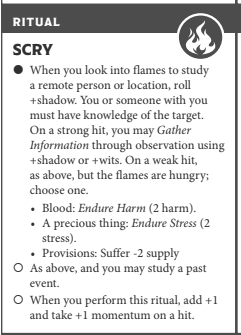
A few sample Assets
The Basics chapter finishes with a Flow of Play chart, which is handy. Like Blades, there's a definite structure to how the game plays out:
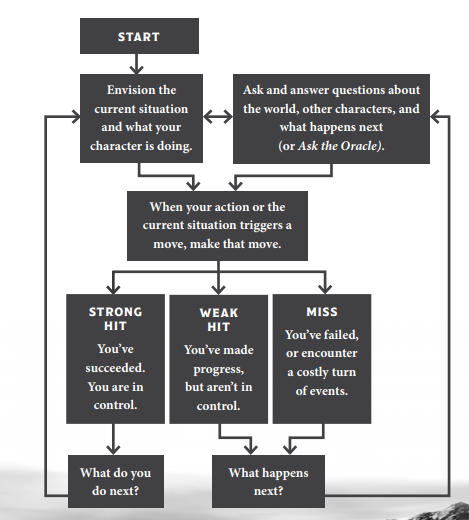
That covers a bunch of the Basics chapter, but once we get into the actual systems I'll go into more detail. In fact, not only will I cover the game, you'll see me play it right before your very eyes!
NEXT TIME: Forging a warrior
Forged in fire
Original SA post
Part 2: Forged in fire
The next chapter is about character creation, and starts out with two basic assumptions about your character. To wit: your character is by default highly skilled and capable, and that you're not bound by any rules in terms of your character's cultural make-up.
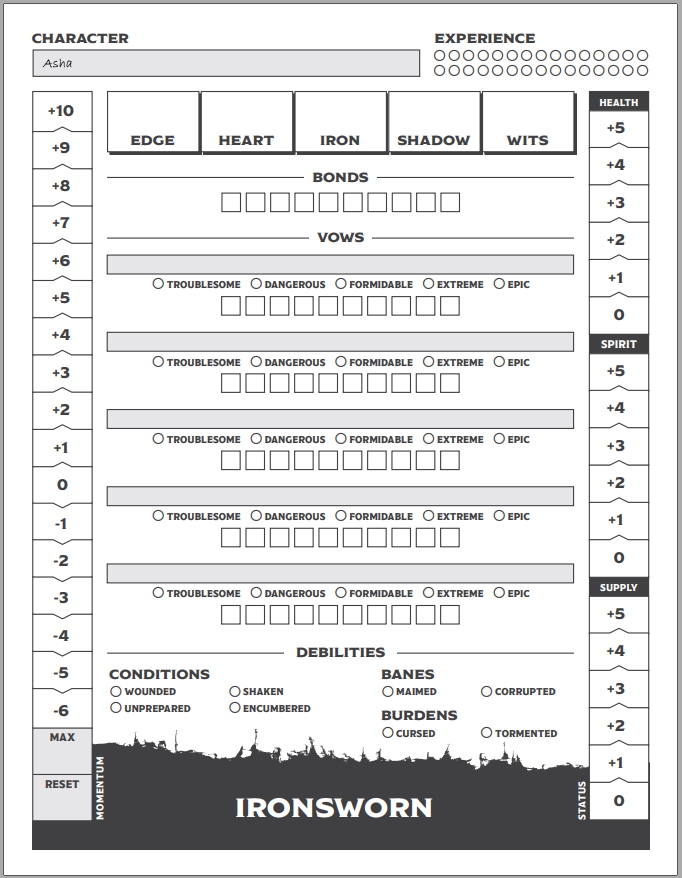
The character sheet
The book also mentions that you can create your setting first (which is covered in chapter 4), make your character first and fill in the world as you go, or do both simultaneously. The game itself supports all three methods, but for the purposes of this read-through I'm going to start with a very basic outline of the world as an idea to hang my character on, then fill in the blanks as I go.
The basic setting I want to use is a simple monster-hunter-y deal; humans are slowly building out into this strange new land, but monsters and impossible beasts are all over the place and constantly attack any settlements on the fringes. As such, new settlements need people to protect the settlers and the territory from outside threats; not only monsters, but threats from humans as well. Basically, just something I can easily set up a basic scenario or two for demonstration purposes. My character will be sworn to the head of a recently-created steading, and will be responsible for protecting it from external threats until it's capable of surviving on its own.
With that done, let's look at the character sheet.
First off we need a name. I'm terrible at this, so I'm going to the tables in the back of the book and grabbing one I like the sound of: Asha.
Characters have five stats:
- Edge, which is basically dexterity; speed, quickness, and skill in ranged combat.
- Heart, which is your strength of will. This measures not just your willpower and courage, but also your empathy.
- Iron is your physical strength, and as such determines your close combat ability.
- Shadow is a measure of how sneaky and deceptive you can be.
- Wits is a general knowledge/observation ability. Given the nature of the game, this is less about book-learnin' (although it does cover that) and more about knowing how to deal with bad situations.
One the right side of the sheet, I have three tracks: Health, Stress, and Supply. The first two are self-explanatory, and the third is an abstract way of keeping track of your character's general gear; food, arrows, camping supplies, things like that.
All three tracks start at +5, but behave a little differently when they hit zero. Bottoming out your Health or Stress tracks doesn't mean you're dead, but means that when you have to make the moves for taking damage/stress (which we'll get to later, of course), you run the risk of suffering permanent debilities, falling into despair, or just flat-out dying. When you run out of supplies, however, you have to make the Out of Supply move and deal with the consequences.
(As a side note: if you're playing this with multiple people, then all characters share one supplies track. When that runs dry, then everyone has to make the Out of Supply move.)
On the left side of the sheet, we have our Momentum track. I talked about Momentum in the first post, but to summarize: Momentum is a measurement of how "in control" of a situation you are and be spent to affect die rolls in your favor. Characters have a default maximum Momentum of +10 and a default Momentum reset of +2. These values are reduced by one for every permanent debility you have, but your reset can't go below +0.
So that all covers Asha's base stats. Now to dig more into who she is.
The main chunk of the sheet is for recording your Bonds and Vows. These are important, because they're going to shape the immediate start of the campaign.
A character starts with three Bonds that represent the people or places closest to them. These don't all have to be defined right away, but at some point all three need to be assigned. Each bond ticks progress (which means drawing one line) on the Bond tracker.
The thing about Bonds is that they all use the same progress track, regardless of how many people you know; this represents your ability to relate to other people. It’s also used at the end of a campaign when your character retires to determine how much of an impact they had on the world around them.
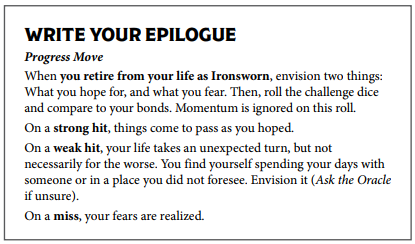
For Asha, I'm going to create all three Bonds right off the bat, and I'm going to use the random tables in the book to come up with names and such.
The first bond will be to the settlement itself. I rolled the name Blackbrook, and that evocative enough to give me a good mental picture of this area: fairly bleak, next to a frigid river that runs from the mountains. It's technically inhabitable, but will require a lot of work to keep things sustainable.
The second bond will be to the settlement's overseer. I'll roll a name and descriptor for this, and get "Kiyone" and "Stingy". That's not a good trait in a leader, but maybe they're the type of person you need in charge of a place where resources will be starting out tight.
The third bond will be with someone completely random. I'm going to roll for name, descriptor, role, and goal. I get "Kotama", "Driven", "Priest", and "Pay a Debt". Paying off a debt matches up nicely with Kiyone's stinginess descriptor; maybe Kotama was manipulated/forced into joining this new settlement and their drive is to finally pay what's owed to Kiyone and get away from the frontier?
So we have our three bonds and did the progress ticks. Now we come to Vows.
As stated in the previous post, Vows are very important in the game, to the point where swearing a vow is its own move. A character starts with two Vows: one long-term one that represents their background, and an immediate one that represents the inciting incident of the campaign.
The background Vow is always either Extreme or Epic; this represents your character's overall goal or motivation, but like all Vows needs to be something you can complete. For Ahsa, I already established that she's protecting Blackbrook from external threats, but that's kind of hard to tag an end goal onto. But that's fine; I don't have to complete this Vow to "finish" the game.
quote:
Fulfilling this vow will not be easy. In story-time, it might require months, years, or even decades to see this vow fulfilled or forsaken. You may even decide your background vow isn’t something you make significant progress on in your narrative. Instead, it just helps establish some roleplaying detail for your character and fleshes out your world.
For the second Vow, I'm going to say that the first adventure will be to hunt down a monster because that's pretty simple to work out. Going through the creatures chapter, most of the "monsters" are either really powerful or some form of undead human. There is the Harrow Spider, which is, as you'd expect, a giant-ass spider. I decide that this thing killed some livestock and carried away one of the settlers, so now I have to find this thing, kill it, and get a locket off the victim's corpse to give his family some closure. Harrow Spiders are classified as a Dangerous enemy, so I'll say that defeating this thing would make for a Dangerous vow.
The final part of character creation is picking my Assets. Assets are your character's actual abilities, and come in four categories: Companions are NPCs (most of which are animals) who'll assist you, Paths represent special backgrounds or training, Combat Talents give you more options when using certain weapons or tactics, and Rituals are magical knowledges you can perform. Assets aren't listed in the book, but are in a separate deck (also available as a free PDF), which I actually like because it saves me having to copy stuff onto my sheet.
Characters start with three Assets of their choosing, although some Assets do have prerequisites. You can't take the "Weaponmaster" Asset until you've completed a Vow in service to an experienced warrior, for example. Some of the prerequisites can be handled during character creation, such as "Masked", which requires you to mark a Bond with the elves. Assets will give you access to new moves, or modify existing moves to your advantage.
I'll take "Skirmisher" to be better at fighting with a spear, and "Slayer" gives her advantages when hunting monsters. For my third Asset, I think I'll take the Hound Companion so I can show those rules off.
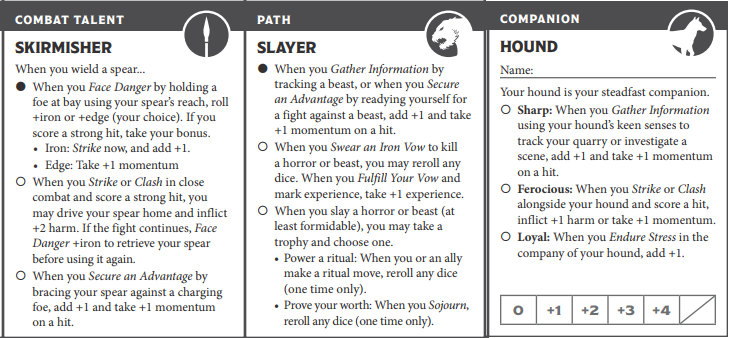
Not a bad loadout for stabbin’.
Skirmisher and Slayer both start with an ability already marked as available for use, whereas I have to pick one which ability I want for my Hound. I'll take Ferocious so I have some help in a fight. The line at the bottom is the Hound's health track; Companions can get clipped by the bad outcomes of my rolls if I roll a 1 while utilizing them.
The only things left on my sheet are for tracking Experience and negative Conditions, Banes, and Burdens. I'm not going to go into these just yet since they don't really matter until they come up from move outcomes.
Here's my final setup for Asha:
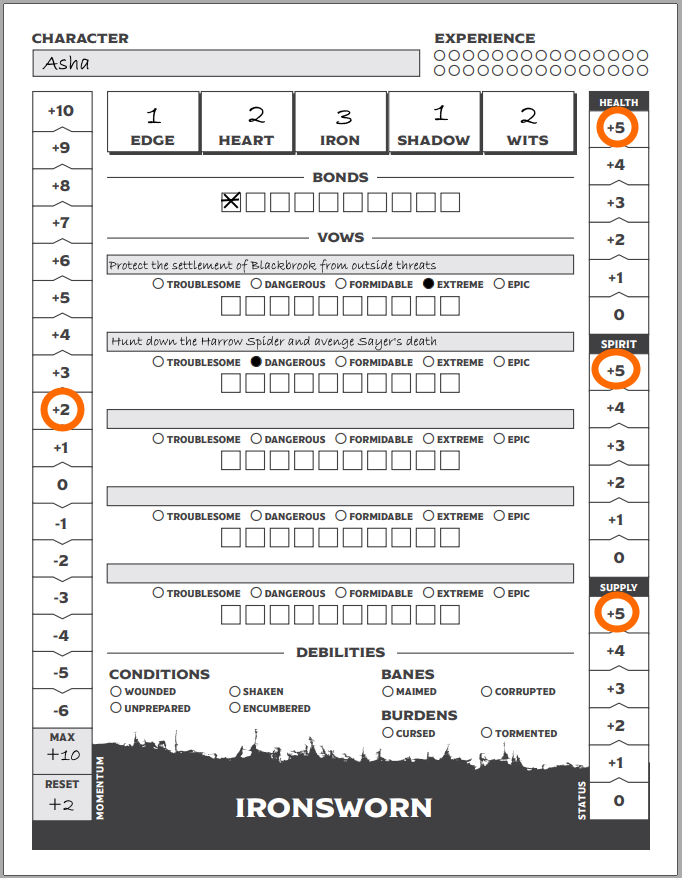
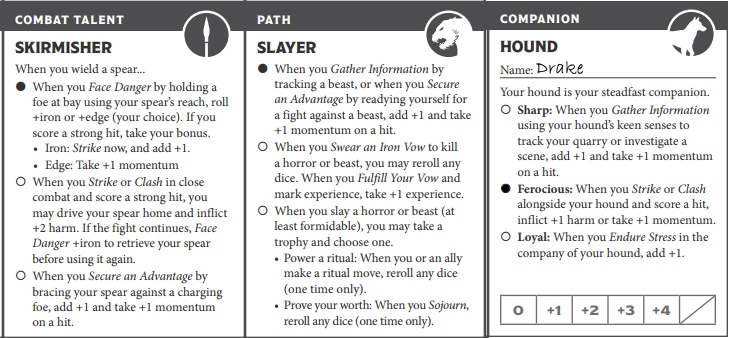
The next chapter is about Moves, but rather than get into a huge blow-by-blow of what all the moves are (mainly because there’s a lot of them), I'll actually start playing so you can see the game in motion.
NEXT TIME: Into The Woods
Moving Forward
Original SA post
Part 3: Moving Forward
Chapter 3 is all about Moves. And Ironsworn has a lot of moves.
Normally I'd be inclined to say that's not a good sign for a PbtA game. After all, it's generally accepted that PbtA games work better when they're focused. Less is more, and all that. But it works in Ironsworn because Shawn Thomkins understands that solo RPGing is a different case. Moves here aren't broad ideas that are prompts for GM moves; they're doing the work of the GM. They're telling you your outcomes instead of providing direction for someone else to come up with the specifics. It also (wisely) separates the moves into distinct categories.
The categories are set up to help structure play, although there's a bit of overlap between them as you'd expect. Adventure Moves, Relationship Moves, and Combat Moves are the ones you'll be using most of the time as you're doing things. Suffer Moves are automatically triggered when you take damage or stress, run out of supplies, or face death. Quest Moves are about making, completing, or breaking Vows. Lastly, there's the two Fate Moves, which are used to determine outcomes: Pay the Price and Ask the Oracle.
So rather than break all these down in a long-ass list nobody's going to read, I'm going to play through a simple adventure and show off the moves as we go. I'll try to hit as many types as I can so you can get a feel for everything.
Get ready to see how bad a writer I really am!
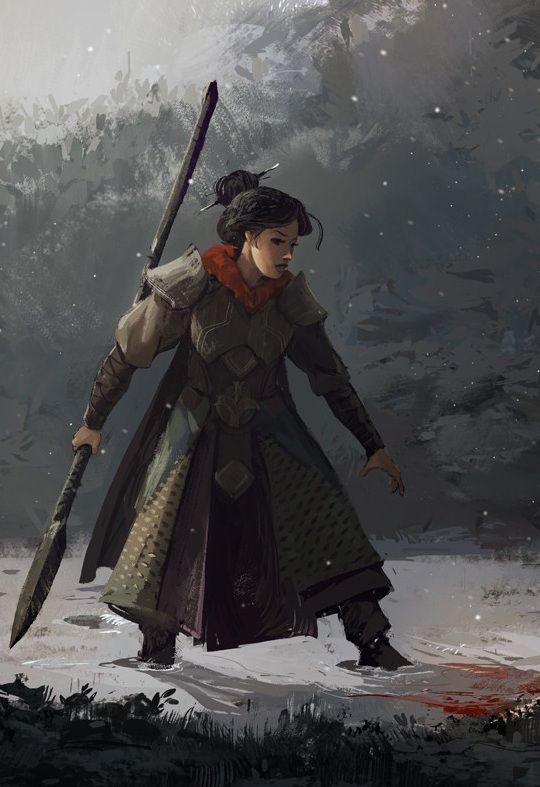
quote:
Blood on the snow is, sadly, not an uncommon sight in the fringes of the Ironlands.
The blood in question in this tale is outside the newly-formed settlement of Blackbrook. It is shortly after dawn, and the hazy sky causes the sun to cast an unpleasant tone over the scene. The corpses of two cows, ripped open by fangs and still steaming. A bloody trail that starts towards the treeline but stops. The wails of a newly widowed woman.
Examining the scene is a heavyset man, his face in a scowl that gives the impression that this is merely a deeper take on his normal expression. As he looks over the carnage, a woman walks up behind him, a large wolfhound at her side. The man barely turns to her as he says, "I thought I brought you here to stop these things from happening, Asha."
The woman doesn't rise to the bait; it's clear she's dealt with this attitude from him before. "I can't magic myself to the other side of the settlement, Kiyone. What happened?"
Kiyone sighs and runs his hand through sparse hair. "I'm not sure. Sayer was getting ready to start working the fields this morning as always, and then I guess some beast came out of the woods and attacked him. Looks like it dragged him off with one of the cows. Killed the other two cows, too."
Asha nodded as her dog began sniffing around the carcasses. "I understand why you're upset; those cows weren't cheap."
Kiyone looked up at the woman sharply. "I'm glad you find this fu-", he started in a harsh voice, but Asha cut him off while still scanning the scene. "Did anyone see what happened?"
The man's jaw clenched for a second as he bit down another comment. "His wife was out here too. I guess she saw the whole thing because she's been a wreck since we found her. We haven't been able to get anything out of her about what happened."
Asha turned to look at the distraught woman sitting on a barrel, surrounded by other members of the settlement. She walked over and knelt down in front of her. "Parella?"
The woman looked up blankly.
Asha's tone was much gentler than it had been when talking to the leader of the settlement. "What happened?"
There was a long pause before Parella answered. "It...it came out of the woods. Just a...a blur. And it killed him. Killed him and took him away..."
"Parella, look at me."
The two lock eyes, and Asha draws her spear. She grips the metal head of it. "I swear to you on this iron, I will find this thing and avenge Sayer's death."
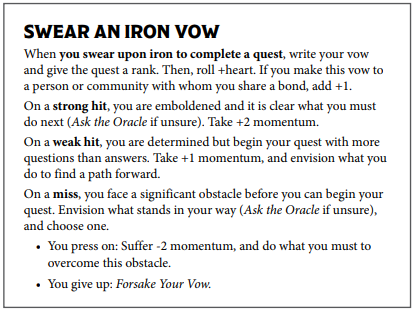
quote:
Fictionally, an iron vow is ceremonial. You touch a piece of iron and speak your vow. Don’t just make the move. Envision how your character enacts the ceremony. What do you do? What do you say? Is this a moment of grudging acceptance or one of fiery determination?
This is one of the more important moves in the game, because it's what ultimately drives the action forward. Since there's no GM to drop plots in your lap, you need to be proactive when it comes to figuring out what you want to do. Completing (or forsaking) Vows is the main narrative engine of the game, as well as how you get XP.
Asha is going to Swear an Iron Vow to avenge Sayer's death. That means rolling 2d10s (the Challenge dice) and 1d6 (the Action die), adding +Heart to the Action die and comparing to each of the Challenge dice. If the Action die beats both Challenges dice, then that's a strong hit, if it beats one it's a weak hit, and if it's the lowest then that's a miss.
Swear an Iron Vow: 1d10=5 1d10=1 1d6+2=3
Only one of the d10s rolled lower than the d6, so that's a weak hit: I get +1 momentum (bringing me to +3), and I have to figure how to find the path forward. Fortunately, that's pretty obvious for the situation; Asha just needs to find the beast's tracks. But first, I just want to close this scene in the narrative so we can get to the next one.
quote:
There's a pause, and Parella just nods mutely. Not an approval, or acceptance, just...acknowledgement.
Asha watches the woman for a moment to see if there's going to be anything else, then nods, mostly to herself. She stands, picking up her supply pack, and walks over to the blood-stained ground that had once been the paddock. Her wolfhound was already sniffing around, trying to pick up a scent.
The hunter looked at the gouges in the hard dirt, examined the bloodstains, studied the carcasses, and in her mind tried to envision the type of beast that could have done so much damage without warning and gotten away so quickly.
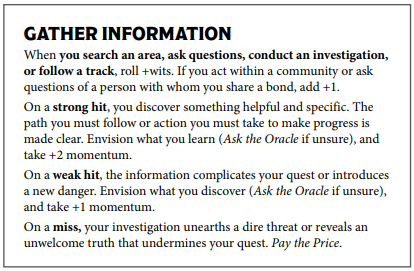
This is going to be +Wits since I'm not using the community to help and don't share a bond with Parella. However, now my Slayer Asset can help me out by giving me another +1 and getting me +1 momentum on a hit.
Gather Information: 1d10=4 1d10=10 1d6+3=7
Another weak hit. Which is still technically a hit so I get the +1 momentum from Slayer, which combined with the +1 from Gather Information brings me to +5.
Unfortunately, there's going to be a complication. I could come up with something, but I think this is a good time to show how you Ask the Oracle.
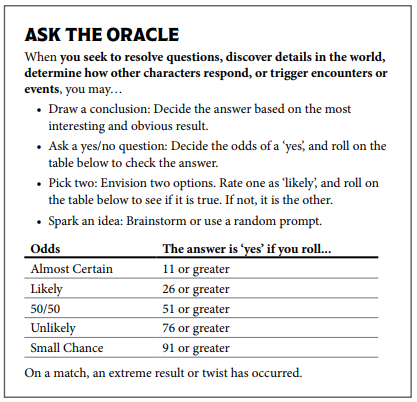
Asking the Oracle is basically a way for me to declaim a bit of decision making. Now, I could just pick an obvious complication like "there's more than one monster", but for the purposes of this demonstration let's pick a second potential problem: the beast's lair is further away than I'd like. This would have a mechanical effect because travelling involves another move (which we'll see in a bit) that can cause more events to occur. The longer the journey, the more likely my resources will be depleted once I get to where I'm going.
So we have two options: "There's more than one monster" and "The monster's lair is far away." Now I need to determine which of the two options is more likely to happen. I feel the "there's more than one" option is the more likely one, given that the beast probably wouldn't be going too far out of its way for food. Now I just need to roll a percentile, and if I get a 26 or better then the more likely outcome is what'll happen.
Ask the Oracle: 1d100 61
quote:
What beast could kill two cows, then carry off another as well as a grown man all by itself? Especially making so many crossing tracks? Arya's shoulders sagged a bit as she put the pieces together. "Crap. There's two of 'em. And whatever they were, they could jump halfway to the treeline carrying all that weight."
She looked down at the wolfhound, who looked up in turn and barked eagerly.
"Yeah, good point Drake. Doesn't matter how many there are, it's our job to deal with them. C'mon boy. Let's go hunting."
And with a final adjustment of her pack, hound by her side, Arya made for the treeline.
When you travel in Ironsworn, you start by making the Undertake a Journey move and give the journey a ten-box progress meter.

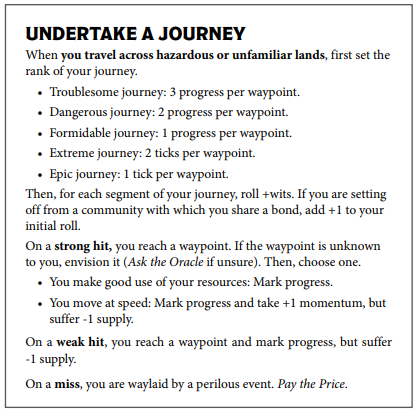
An important thing to understand here is that while this is a progress meter, the goal is not to fill it up completely. I can chose at any point after the initial roll to end the journey and make the Reach Your Destination move, even if only one box is filled.
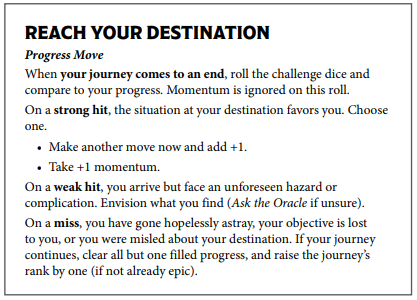
As stated, the number of filled boxes replaces the Action Die when I roll to see what state I'm in when I get to where I'm going. This means that I want to roll Undertake a Journey more rather than less, since that's what fills in boxes. But this is a risk/reward thing; the more times I Undertake a Journey, the more chances that I'll flub a roll and introduce complications or reduce my resources. (This is why I had "the lair is further away" as a consequence; longer journeys can have more complications.)
For the purposes of this demo, I'm just going to make this a Trivial journey to keep things moving. This means that I could make the Reach Your Destination with an okay chance of success after "journeying" twice, or high odds of success after three "journeys". Of course, this assumes I make those rolls well enough that I don't suffer bad consequences. And like I said, the more rolls I make (either to fill the track or because the journey is longer), the more likely I'll suffer some drawbacks.
Undertake a Journey refers to "waypoints"; this is a blanket term for any point of interest I come across in my travels. A settlement can be a waypoint, as could a ruin, a geological figure, or similar. Waypoints are important because I can use them to make camp, resupply, or just refocus. And yes, each of those have their own moves.
For now, let's just see how the first part of Arya's hunt goes. I'm rolling +Wits, with another +1 because I'm setting out from a place I have Bonds.
Undertake a Journey: 1d10=8 1d10=9 1d6+3=9
Oof, barely a weak hit; I need the Action Die to beat the d10s, not match them. Still, that lets me mark progress and gets me to a waypoint. The downside is that it costs me a point of Supply, putting me at +4. Not a huge deal, I'm probably still in good shape given how short this journey will be.

quote:
The trail was easy to follow; broken trees and bloodstains aren't exactly subtle. Whatever these things were, they wanted to get away and didn't give a shit about what was between them and home.
It's not far into the forest when Arya finds the remnants of an old hunting camp. Probably from the early days of the settlement, back before people realized that the forest contained more creatures than game. There was a rusted cooking pot half-buried in the dirt, and the stone circle that had marked a campfire was still mostly intact.
Arya looked around the clearing, taking some jerky from her pack and chewing on it thoughtfully. The...events that had happened during the early hunting attempts are what got Kiyone to bring her here months ago, and to this day she was still not sure how she felt about it.
She shook her head. No point in self-examination right now; there were beasts to kill.
Because I made progress on a Trivial journey, I fill in three boxes on the progress track. Making a roll against a 3 isn't good odds, so let's make another Journey roll.
Undertake a Journey: 1d10=8 1d10=8 1d6+2=3
Uh oh.
So a few things just happened. First off, I failed the roll. This means I need to Pay the Price. The other thing is that I rolled doubles on the Challenge Dice, which is always a crit...in this case, it's a critical failure.

Now this is where things get tricky. The most obvious option here is that I get jumped by one of the spiders. I wouldn't be near their lair, because that would actually work to my advantage since that's the end of my journey. I might be jumped by one of them but still have to track the other one down, but I feel like fighting two creatures one at a time is easier than two at once, so that's not really crit-fail worthy. Let's roll for it and see what comes up.
Pay the Price: 1d100=8
"A person or community you care about is exposed to danger." Oh...oh, I think I have a good one for this.
quote:
Asha knows how to move silently through the woods. Those hunters who don't generally don't last long. Even Drake knows how to stay quiet. The beasts she hunts know it too; prey is easily spooked, after all.
So it's a bit of a surprise when she hears something coming up behind her and making no attempt to be quiet.
The hunter quickly finds a hiding spot in the foliage, guiding Drake to a supporting position with a quick hand signal. She waits; a good hunter knows how to keep still, too.
She watches a figure approach through the trees, carrying a sword and stumbling over every available root and stone possible. And her eyes widen in recognition.
"Parella?" She stood up quickly before the other woman got too close, but Parella still jumped back in surprise and raised the sword with obvious difficulty. "What the hell are you doing out here?"
Parella lowered the sword, trying to look defiant through her grief. "What do you think I'm doing? I'm here to help you kill the beasts that ki...killed my..." For a moment she looks on the verge of tears again, but she managed to keep it together. "I'm here to help you."
Asha stared at her, trying not to just yell. "Are you cr...I mean, Parella. This is dangerous! I don't even know what I'm hunting yet. Do you even know how to use that sword?"
The farmer raised her chin. "I know enough."
"So no, then."
Parella's jaw set. "I'm helping you and that's that. Would you rather I just sat doing nothing and waited for you to come back?"
There was a pause. "Yes! That's exactly what I expect! That's why I'm here! To be the one who does this stuff so people like you don't get hurt!"
As soon as the words left her mouth, she knew it was the wrong thing to say. Parella's eyes narrowed. "You didn't do your job for Sayer, did you," she asks coldly.
Asha paused once again. She didn't have time for this; she certainly didn't have time to bring Parella back to the village and risk the trail getting cold. "Fine. But listen to me: I'm the one who knows how this works. You need to listen to me and follow my lead, understand?"
Parella just nods. Drake finally comes out of his hiding spot and pads over to Parells, who looks down, smiles slightly, and scratches his head. Drake turns to face his owner and sits next to Parella with the air of a guardian.
Asha looks down at him and sighs. "Traitor."
NEXT TIME: Escort mission